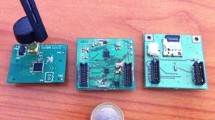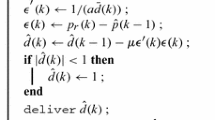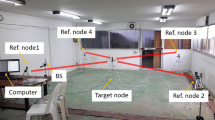Abstract
In this study, theoretical limits in position estimation in Wireless Sensor Network (WSN) using a trilateration method are derived in the form of probability density functions (PDFs) and compared with practical limits obtained via received signal strength (RSS) measurements in an anechoic chamber. In particular, the PDF of the radius of error of an unknown node’s position has been derived as having a Nakagami-m distribution. The theoretical PDFs is validated via Kolmogorov–Smirnov hypothesis tests at 95% confidence level against the empirical results of position estimation in a 4 m × 4 m area using the RSS measured in an ideal environment of an anechoic chamber. High-resolution equipment is used in the RSS measurements to ensure the inaccuracies due to limited-capability WSN equipment can be quantified. A lower bound of positioning accuracy to be expected in real environments via the received signal strength method has been established to be in the range of 11 cm from the true position with 95% confidence level. Better results cannot be expected in the real environments with bigger variations than the variations observed in the anechoic chamber unless a more sophisticated algorithm, equipment with better resolution and/or more precise measurement methods are employed.








Similar content being viewed by others
References
(2013) CC2420 datasheet [Online]. http://www.ti.com/lit/ds/symlink/cc2420.pdf. Accessed: 28 January, 2018.
Al Alawi, R. (2011). RSSI based location estimation in wireless sensors networks. In 17th IEEE international conference on networks (pp. 118–122). https://doi.org/10.1109/ICON.2011.6168517.
Alsindi, N., et al. (2014). An empirical evaluation of a probabilistic RF signature for WLAN location fingerprinting. IEEE Transactions Wireless Communications, 13(6), 3257–3268. https://doi.org/10.1109/TWC.2014.041714.131113.
Bensky, A. (2016). Wireless positioning technologies and applications, ch. 1, sec. 3 (2nd ed., pp. 7–10). Norwood, MA: Artech House.
Berber, S. M., et al. (2014). Measurement and mean power estimation in indoor wireless channel based on higher order Kalman filtering. IEEE Transactions on Instrumentation and Measurements, 63, 2771–2778. https://doi.org/10.1109/TIM.2014.2320832.
Boano, C. A., et al. (2014). Mitigating the adverse effects of temperature on low-power wireless protocols. In IEEE 11th international conference on mobile ad hoc and sensor system (pp. 336–344). IEEE. https://doi.org/10.1109/MASS.2014.14.
Bryant, G. H. (1993). Wireless positioning technologies and applications. Bristol: Peregrinus.
Chen, Y., & Terzis, A. (2010). On the mechanisms and effects of calibrating RSSI measurements for 802.15.4 radios. In Wireless sensor networks: 7th European conference (pp. 256–271). Berlin: Springer. https://doi.org/10.1007/978-3-642-11917-0_17.
Chizhik, D., et al. (2012). Radio wave diffusion indoors and throughput scaling with cell density. IEEE Transactions Wireless Communications, 11, 3284–3291. https://doi.org/10.1109/TWC.2012.062012.111779.
Coluccia, A. (2013). Reduced-bias ML-based estimators with low complexity for self-calibrating RSS ranging. IEEE Transactions Wireless Communications, 12(3), 1220–1230. https://doi.org/10.1109/TWC.2013.011713.120557.
Gezici, S. (2008). A survey on wireless position estimation. Wireless Personal Communications, 44(3), 263–282. https://doi.org/10.1007/s11277-007-9375-z.
Goldsmith, A. (2005). Wireless communications, ch. 3, sec. 2 (p. 79). Cambridge: Cambridge University Press.
Jiang, J. A., et al. (2013). A distributed RSS-based localization using a dynamic circle expanding mechanism. IEEE Sensors Journal, 13(10), 3754–3766. https://doi.org/10.1109/JSEN.2013.2258905.
Kendall, M., & Stuart, A. (1977). The advanced theory of statistics (4th ed., Vol. 1). London: Charles Griffin and Company Ltd.
Konings, D., et al. (2017). Do RSSI values reliably map to RSS in a localization system? In 2nd workshop on recent trends in telecommunication research (RTTR) (pp. 1–5). https://doi.org/10.1109/RTTR.2017.7887867.
Lee, W. Y., et al. (2012). Mobile robot navigation using wireless sensor networks without localization procedure. Wireless Personal Communications, 62(2), 257–275. https://doi.org/10.1007/s11277-010-0052-2.
Liu, Y., et al. (2017). RSS-based ranging by leveraging frequency diversity to distinguish the multiple radio paths. IEEE Transactions on Mobile Computing, 16, 1121–1135. https://doi.org/10.1109/TMC.2016.2579619.
MacCartney, G. R, Jr., et al. (2015). Indoor office wideband millimeter-wave propagation measurements and channel models at 28 and 73 GHz for ultra-dense 5G wireless networks. IEEE Access, 3, 2388–2424. https://doi.org/10.1109/ACCESS.2015.2486778.
Marsaglia, G., et al. (2003). Evaluating Kolmogorov’s distribution. Journal of Statistical Software, 8(18), 1–4. https://doi.org/10.18637/jss.v008.i18.
Mohd Azmi, K. (2017). Derivations of probability density functions for indoor position estimation. Technical report, The University of Auckland.
Mohd Azmi, K., et al. (2016). Channel parameters and distance estimation in wireless sensor networks based on maximum likelihood estimation method. In International conference on computing and communication engineering (pp. 400–405). IEEE. https://doi.org/10.1109/ICCCE.2016.91.
Ning, C., et al. (2016). Outdoor location estimation using received signal strength-based fingerprinting. Wireless Personal Communications, 89(2), 365–384. https://doi.org/10.1007/s11277-016-3270-4.
Papoulis, A., & Pillai, S. U. (2002). Probability, random variables and stochastics processes (4th ed.). New York: McGraw-Hill.
Pivato, P., et al. (2011). Accuracy of RSS-based centroid localization algorithms in an indoor environment. IEEE Transactions on Instrumentation and Measurement, 60(10), 3451–3460.
Rappaport, T. S. (1996). Wireless communications, ch.3, sec. 11 (1st ed., pp. 123–133). Upper Saddle River, NJ: Prentice Hall PTR.
Sharma, G., & Kumar, A. (2017). Dynamic range normal bisector localization algorithm for wireless sensor networks. Wireless Personal Communications, 97(3), 4529–4549. https://doi.org/10.1007/s11277-017-4736-8.
Shnidman, D. A. (1995). Efficient computation of the circular error probability (CEP) Integral. IEEE Transactions Automatic Control, 40(8), 1472–1474. https://doi.org/10.1109/9.402244.
Silva, H. D., et al. (2016). Body attenuation and path loss exponent estimation for RSS-based positioning in WSN. Wireless Personal Communications, 94(3), 1–23. https://doi.org/10.1007/s11277-016-3653-6.
Wang, Y., et al. (2013). Propagation characteristics of the LTE indoor radio channel with persons at 2.6 GHz. IEEE Antennas and Wireless Propagation Letters, 12, 991–994. https://doi.org/10.1109/LAWP.2013.2275811.
Weiss, A. J. (2003). On the accuracy of a cellular location system based on RSS measurements. IEEE Transactions on Vehicular Technology, 52(6), 1508–1518. https://doi.org/10.1109/TVT.2003.819613.
Xue, W., et al. (2017). Improved Wi-Fi RSSI measurement for indoor localization. IEEE Sensors Journal, 17, 2224–2230. https://doi.org/10.1109/JSEN.2017.2660522.
Yiğitler, H., et al. (2017). On log-normality of RSSI in narrowband receivers under static conditions. IEEE Signal Processing Letters, 24, 367–371. https://doi.org/10.1109/LSP.2017.2657332.
Zanella, A. (2016). Best practice in RSS measurements and ranging. IEEE Communications Surveys & Tutorials, 18, 2662–2686. https://doi.org/10.1109/COMST.2016.2553452.
Zhang, Y., et al. (2009). The design and implementation of a RSSI-based localization system. In 5th international conference on wireless communications, networking and mobile computing (pp. 1–4). https://doi.org/10.1109/WICOM.2009.5303968.
Author information
Authors and Affiliations
Corresponding author
Additional information
Publisher's Note
Springer Nature remains neutral with regard to jurisdictional claims in published maps and institutional affiliations.
Rights and permissions
About this article
Cite this article
Mohd Azmi, K.H., Berber, S.M. & Neve, M.J. Theoretical and Practical Limits in Position Estimation Based on Received Signal Strength Measurements. Wireless Pers Commun 111, 1295–1311 (2020). https://doi.org/10.1007/s11277-019-06915-9
Published:
Issue Date:
DOI: https://doi.org/10.1007/s11277-019-06915-9




